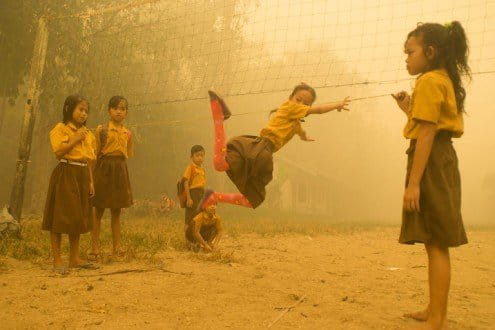- In 2019, volunteers with the environmental wing of Indonesia’s largest Islamic women’s organization, ‘Aisyiyiah, operated “Rumah Oksigen,” homes equipped with air purifiers and first aid.
- This year as El Niño strengthens, ‘Aisyiyah will advise members to reopen the facilities for the young, old and those most susceptible to air pollution generated by wildfires.
- The volunteers will also work to raise awareness in the community on how families can best protect themselves.
Indonesia’s oldest women’s Islamic organization will prepare volunteers in Kalimantan and Sumatra to open clean air sanctuaries, should a strengthening El Niño accelerate wildfires over the coming months.
“We will make sure the LLHPB will protect our children, women, our network and the community around the forest fires to make sure they stay alive and stay healthy in this situation,” said Hening Purwati Parlan, the vice chair of ‘Aisyiyah’s environmental and disaster management wing, the Lembaga Lingkungan Hidup dan Penanggulangan Bencana (LLHPB).
Indonesia’s first Islamic women’s organization was founded in 1917 to advocate for education rights for girls. Today ‘Aisyiyah, part of the Muhammadiyah Islamic organization, claims more than 4 million members across the world’s largest Muslim-majority country.
In 2015, ‘Aisyiyah established its environmental arm, the LLHPB, to respond to environmental damage in the community and address harms from climate change, adding to existing gender initiatives in the community, such as prevention of child marriage.
In 2022, while head of the LLHPB, Hening wrote a paper setting out the case for an “eco-jihad,” a spiritual struggle to confront climate change, among ‘Aisyiyah’s followers. “The impacts of climate change can no longer be handled as normal, there is a need to handle it with urgency,” Hening wrote, citing the Surah Al-A’raf, verses 56-58 in the Koran.
Oxygen homes
As wildfires burned through 3.1 million hectares (7.7 million acres) of land in Indonesia over the course of 2019, ‘Asiyiyah volunteers operated Rumah Oksigen (“Oxygen Homes”) equipped with air purifiers to aid the most susceptible to hazardous air circulating outside.

“The pollution was so high outside, so we protect them in the home,” Hening said. “It’s like an emergency home.”
One study by Harvard and Columbia universities suggested air pollution from Southeast Asia’s 2015 wildfire catastrophe may have caused 100,000 early deaths.
At its upcoming annual meeting in Jakarta, Indonesia’s capital, in mid-July, the organization will emphasize the importance of women raising awareness in communities.
“Education and awareness for women and children — distributing information on how to protect themselves,” Hening said. “Awareness is very important.”
In addition, ‘Aisyiyah’s leadership will advise volunteers in provinces at risk from wildfires to be prepared to open the Oxgyen Homes if El Niño sparks severe wildfires over the coming months.
‘Aisyiyah volunteers in the field said they were ready to reprise the system if El Niño fueled wildfires comparable to 2019.
“If the condition is an emergency like at that time, then it will be possible to reopen [the Oxygen Homes], and we can develop more,” said Widati Irma, the head of the LLHPB in Riau province.
In West Kalimantan province, two Oxygen Homes have remained active every year since the 2019 fires, staffed by volunteers from ‘Aisyiyah as well as university health and nursing faculties.
“We must always be on standby,” said Ramah Susanti in West Kalimantan. “The Oxygen Home is always ready for the people of West Kalimantan.”

Air support
In mid-June the Climate Prediction Center at the U.S. National Oceanic and Atmospheric Administration (NOAA) announced El Niño conditions had arrived for the first time since 2019 and would strengthen through October. Indonesia’s meteorology agency has advised that a potentially dangerous dry season looms, elevating risks of wildfires burning on the world’s largest reserves of tropical peatlands.
“The fires in 2019 really provided a lesson for everyone about the environment and forests,” said Ramah in West Kalimantan. “Schools were closed, all activities were paralyzed.”
In 2020, President Joko Widodo ordered government officials to find a “permanent solution” to wildfires after the 2019 dry season, which was exacerbated by a positive Indian Ocean Dipole, where warmer sea surface temperatures in the Indian Ocean lead to less rainfall.
A legal crackdown on small farmers burning biomass has ensued, together with efforts to raise the capacity of farmers and community firefighters to prevent damaging wildfires. The head of Indonesia’s disaster management agency said earlier this month that officials were confident of better infrastructure in the field compared with four years ago.
Indonesia has won praise after the archipelago recorded significant falls in wildfire damage between 2020 and July 2023. However, experts say the first El Niño event since 2019 presents a major test, and a worry for those who live in the firing line.
“This year there will be a heat storm from El Niño,” said Rahmah Susanti. “This will definitely make us more worried about wildfires in vulnerable areas.”
Banner: Trucks loaded with oil palm fruits drive through haze in Indonesia’s Rokan Hilir district. Photo courtesy of Greenpeace Media Library.
FEEDBACK: Use this form to send a message to the author of this post. If you want to post a public comment, you can do that at the bottom of the page.







